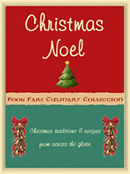|
Contents:
More:
Get the e-book edition of "Christmas Noel" >
|
Legends of Santa Claus
Today, however, his character is still alive and well in much of the world. St. Nicholas' legend spread quickly during the Middle Ages, when literally thousands of churches were dedicated to him. He has been the patron saint of Greece, Russia, and of children, prisoners, pawnbrokers, bakers, sailors and wolves. The scant remains of St. Nicholas are said to be in the basilica of St. Nicola in Italy.
Some of the common facts about Santa:
In Europe in the 12th century "Saint Nicholas Day" was an occasion of charity and gift-giving. Holland, France and Germany celebrated the holiday on December 6th mostly as a religious event, while gifts were only given to the poor and to children.
Santa Claus is also known by many different names around the world. A few of them are familiar, although some are not so well-known. In Germany, Santa has a few different monikers such as "Kriss Kringle," "Christkind" and "Saint Nicholas." In Japan, they call St. Nick "Santa Kurohsu." In Russia, he is known as "Basbouschka." In France and Monaco, he is called "Pere Noel" or "Le Petit."
America's image of Santa evolved from a jolly, old elf. He was first described in the comic piece known as the "History of New York" by Washington Irving. In 1823, the Santa legend grew with the publication of a poem called "A Visit from St. Nicholas" by Clement Moore (re: Twas the night before Christmas, when all through the house, not a creature was stirring, not even a mouse).
Many different countries have maintained their own traditions regarding Saint Nicholas. In Holland, he arrives by ship on December 6th carrying a large book which tells him if children have behaved through the year. Good children receive gifts, but naughty children are taken away by Santa's sinister assistant, "Black Peter."
In Germany, Saint Nicholas also travels with an intimidating assistant known as "Krampus." The assistant comes with a sack and rod in hand. Well behaved children receive a present from the sack, but bad children get a few whips from the rod.
In Spain and Mexico, children eagerly await the "Three Kings" to bring their presents. In France and Monaco, "Pere Noel" comes laden with gifts, while in Switzerland the "Christkindl" (Christ Child) bears the presents.
And, as we all know, North America has the plump and jolly Santa arriving in a sleigh pulled by reindeer. He often comes down the chimney with his sack of goodies, leaving before the children awaken but only after partaking his prerequisite milk and cookies.
|
![]() Christmas Noel ©Food Fare
Christmas Noel ©Food Fare
![]() Webmaster:
Webs Divine
Webmaster:
Webs Divine
![]()



 The
American version of Santa Claus derives from the Dutch ("Sint Klaas"). According
to some historians, Dutch settlers in New York brought "Sint Klaas" with them to
the United States. Santa is known by several different names throughout the
word: el Nino Jesus, Father Christmas, Grandfather Frost,
Kriss Kringle, Pere Noel, St. Nick, Santa no ojisan,
Shengdan Laoren, et al. He is said to have been born "St. Nicholas" in
the city of Patara, traveling to Egypt when he was young.
The
American version of Santa Claus derives from the Dutch ("Sint Klaas"). According
to some historians, Dutch settlers in New York brought "Sint Klaas" with them to
the United States. Santa is known by several different names throughout the
word: el Nino Jesus, Father Christmas, Grandfather Frost,
Kriss Kringle, Pere Noel, St. Nick, Santa no ojisan,
Shengdan Laoren, et al. He is said to have been born "St. Nicholas" in
the city of Patara, traveling to Egypt when he was young. He
is a merry fat man in a red suit.
He
is a merry fat man in a red suit. In
1860, the illustrated "Harper's Weekly" displayed cartoon images of a plump and
jolly Santa, drawn by Thomas Nash. The image of Santa was becoming part of
American culture, a tradition which found its way back to Europe and on to South
America, as well as the rest of the world.
In
1860, the illustrated "Harper's Weekly" displayed cartoon images of a plump and
jolly Santa, drawn by Thomas Nash. The image of Santa was becoming part of
American culture, a tradition which found its way back to Europe and on to South
America, as well as the rest of the world. In
Scandinavian countries an elf called "Julenisse" comes with toys. In England and
Wales, "Father Christmas" (a much thinner and nobler version of Santa)
brings the presents.
In
Scandinavian countries an elf called "Julenisse" comes with toys. In England and
Wales, "Father Christmas" (a much thinner and nobler version of Santa)
brings the presents.